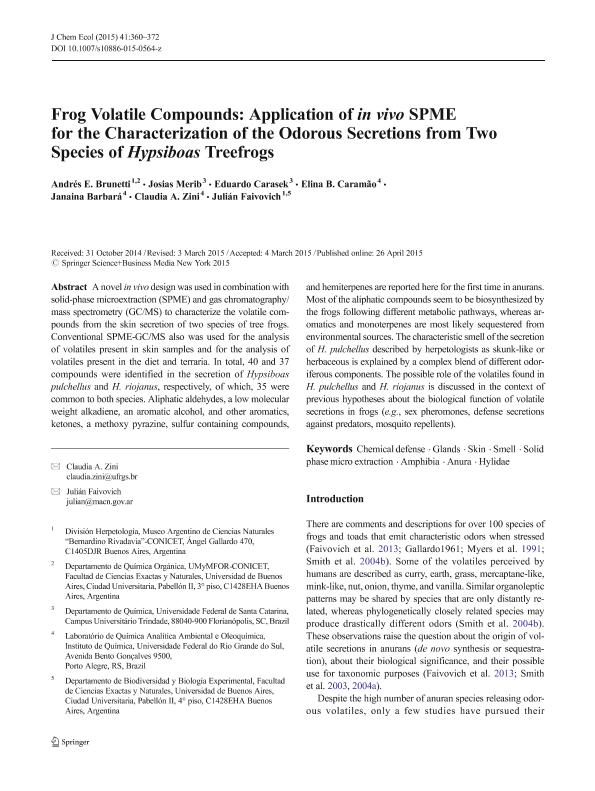Artículo
Frog Volatile Compounds: Application of in vivo SPME for the Characterization of the Odorous Secretions from Two Species of Hypsiboas Treefrogs
Brunetti, Andrés Eduardo ; Merib, Josias; Carasek, Eduardo; Caramão, Elina B.; Barbará, Janaina; Zini, Claudia A.; Faivovich, Julián
; Merib, Josias; Carasek, Eduardo; Caramão, Elina B.; Barbará, Janaina; Zini, Claudia A.; Faivovich, Julián
 ; Merib, Josias; Carasek, Eduardo; Caramão, Elina B.; Barbará, Janaina; Zini, Claudia A.; Faivovich, Julián
; Merib, Josias; Carasek, Eduardo; Caramão, Elina B.; Barbará, Janaina; Zini, Claudia A.; Faivovich, Julián
Fecha de publicación:
04/2015
Editorial:
Springer
Revista:
Journal of Chemical Ecology
ISSN:
0098-0331
e-ISSN:
1573-1561
Idioma:
Inglés
Tipo de recurso:
Artículo publicado
Clasificación temática:
Resumen
A novel in vivo design was used in combination with solid-phase microextraction (SPME) and gas chromatography/mass spectrometry (GC/MS) to characterize the volatile compounds from the skin secretion of two species of tree frogs. Conventional SPME-GC/MS also was used for the analysis of volatiles present in skin samples and for the analysis of volatiles present in the diet and terraria. In total, 40 and 37 compounds were identified in the secretion of Hypsiboas pulchellus and H. riojanus, respectively, of which, 35 were common to both species. Aliphatic aldehydes, a low molecular weight alkadiene, an aromatic alcohol, and other aromatics, ketones, a methoxy pyrazine, sulfur containing compounds, and hemiterpenes are reported here for the first time in anurans. Most of the aliphatic compounds seem to be biosynthesized by the frogs following different metabolic pathways, whereas aromatics and monoterpenes are most likely sequestered from environmental sources. The characteristic smell of the secretion of H. pulchellus described by herpetologists as skunk-like or herbaceous is explained by a complex blend of different odoriferous components. The possible role of the volatiles found in H. pulchellus and H. riojanus is discussed in the context of previous hypotheses about the biological function of volatile secretions in frogs (e.g., sex pheromones, defense secretions against predators, mosquito repellents).
Archivos asociados
Licencia
Identificadores
Colecciones
Articulos(MACNBR)
Articulos de MUSEO ARG.DE CS.NAT "BERNARDINO RIVADAVIA"
Articulos de MUSEO ARG.DE CS.NAT "BERNARDINO RIVADAVIA"
Articulos(UMYMFOR)
Articulos de UNID.MICROANAL.Y MET.FISICOS EN QUIM.ORG.(I)
Articulos de UNID.MICROANAL.Y MET.FISICOS EN QUIM.ORG.(I)
Citación
Brunetti, Andrés Eduardo; Merib, Josias; Carasek, Eduardo; Caramão, Elina B.; Barbará, Janaina; et al.; Frog Volatile Compounds: Application of in vivo SPME for the Characterization of the Odorous Secretions from Two Species of Hypsiboas Treefrogs; Springer; Journal of Chemical Ecology; 41; 4; 4-2015; 360-372
Compartir
Altmétricas



